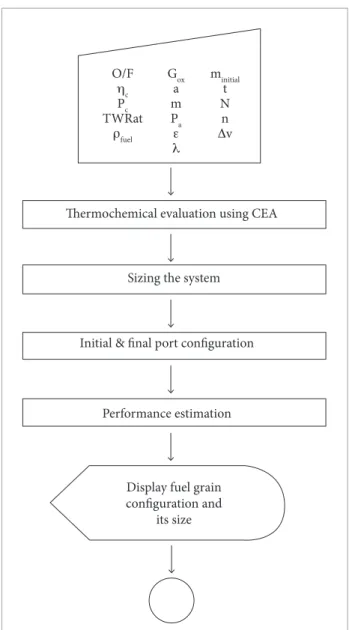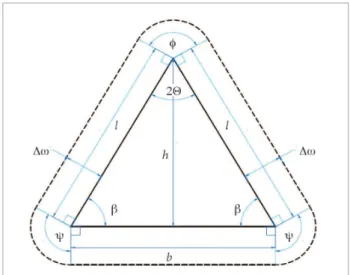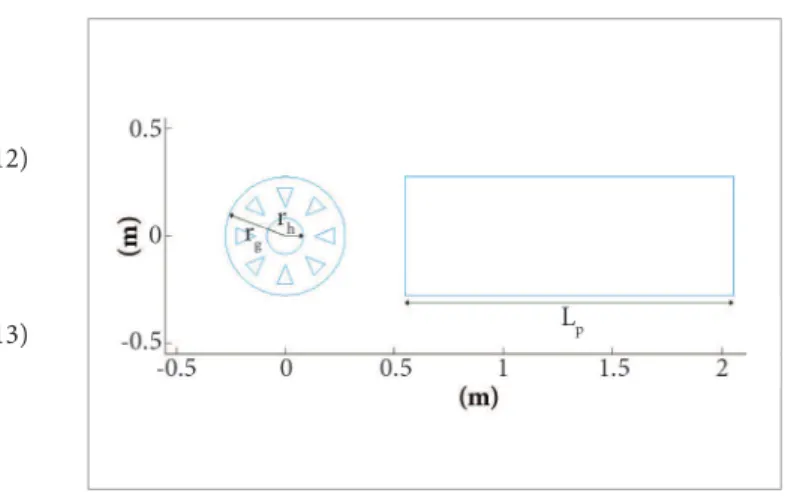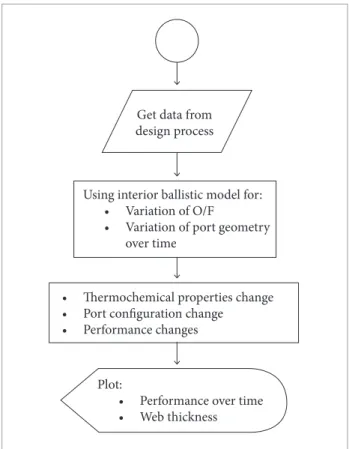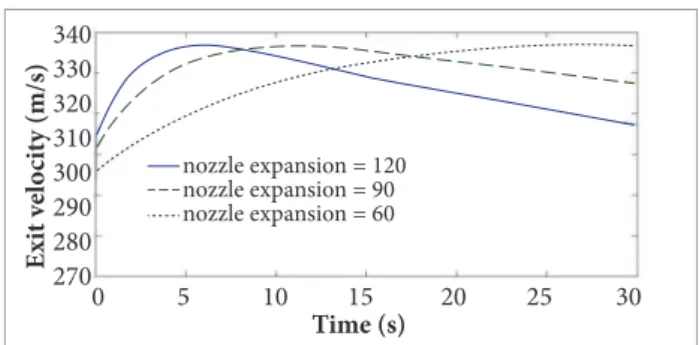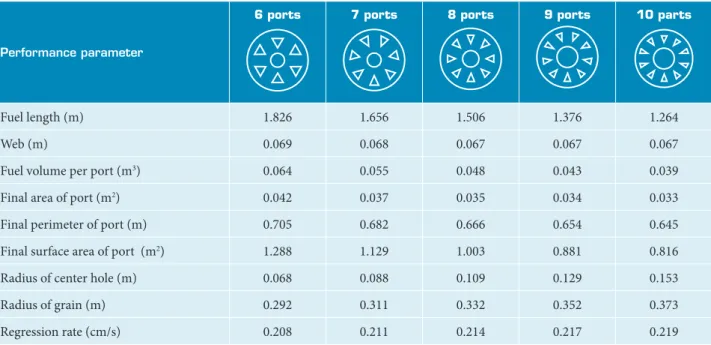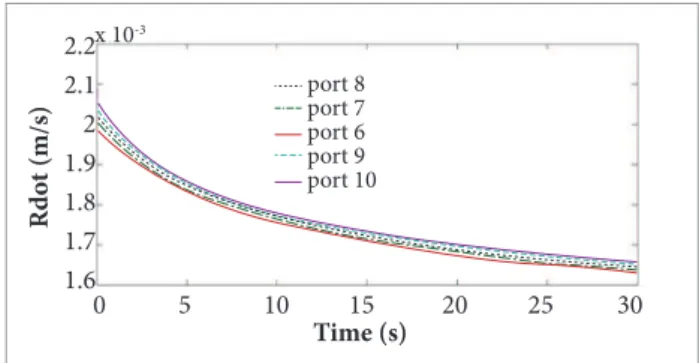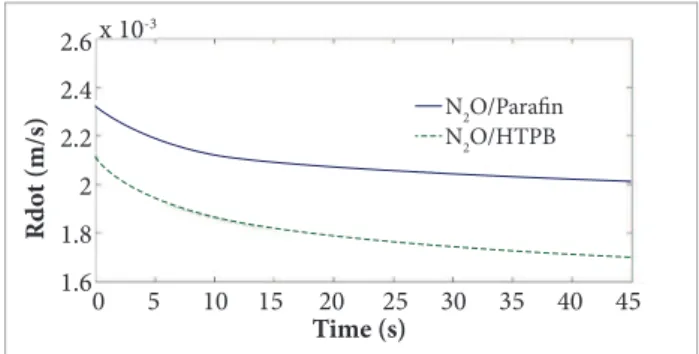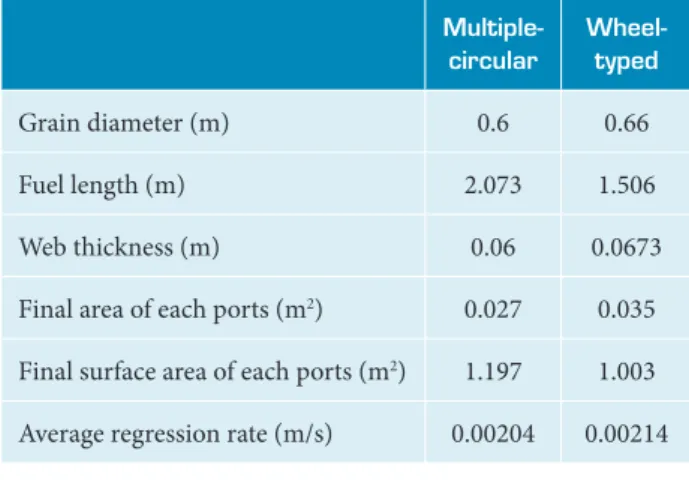ABSTRACT: Hybrid rockets provide compelling features for use in atmospheric and space rocket propulsion. One of the prominent applications of hybrid rockets which foster on its characteristics is the propulsion of micro air launch vehicles. In this paper, a set of design options of a hybrid rocket motor is evaluated for propulsion of micro air launch vehicles. In order to evaluate the various design options of a hybrid rocket, we developed design and performance simulation codes. A simulation code is based on a legacy interior ballistic model. MATLAB® environment was used to develop the design and performance analysis codes and to visualize the temporal variation of performance characteristics and grain geometry during burning. We employ the developed codes to assess the replacement of solid rocket motors which are typically used in Air Launch Vehicles by hybrid rocket motors. A typical Micro Air Launch Vehicle mission to launch a 20-kg payload into a 400-km circular polar orbit is assumed. The results show that a hybrid rocket is a suitable candidate for micro air launch vehicles. The performance is improved in terms of speciic impulse and thrust with smaller size in the same mission. Several design parameters of hybrid rocket motors were also evaluated and analyzed, including different fuel port geometry, type of fuels and oxidizers, number of ports, nozzle design and initial mass lux. These design parameters bring a signiicant effect on hybrid rocket performance and size.
KEYWORDS: Hybrid rocket, Micro air launch vehicle, Internal ballistics, Regression rate.
Effect of Varying Design Options on the
Transient Behavior of a Hybrid Rocket Motor
Raed Kafafy1, Muhammad Hanai Azami1, Moumen Idres1
INTRODUCTION
Hybrid rockets are featured with restarting capability, increased safety, high performance and relatively moderate cost. This unique combination of compelling features poses them as prominent candidates to replace solid rocket motors in air-launched tactical missiles and launch vehicles, besides liquid rocket engines in ground-launched strategic missiles and launch vehicles in the near future. A hybrid rocket is comprised of fuel and oxidizer in different physical states, typically a solid fuel and a liquid or gaseous oxidizer. It represents a compromise between a solid rocket motor and a liquid rocket engine (Mingireanu, 2009). In general, hybrid rockets have specific impulse higher than solid rockets and specific impulse density greater than liquid bi-propellant rockets (Kannalath et al., 2003).
Wax based hybrid rocket motors are toxic, non-hazardous, shippable as freight cargo, potentially carbon neutral and they can be throttled for thrust control or shut down in case of in-flight anomaly then restart on demand (DeSain et al., 2009). In 2004, the Ansari X Prize has put
hybrid technology to a brighter future with the successful launch of SpaceShipOne (David, 2004). SpaceShipOne was succeeded by SpaceShipTwo, which is as nearly twice in size and passed the first powered test flight in April 2013.
Despite the advantages of hybrid rockets, there are several shortcomings which are specifically related to overall performance, reliability and cost effectiveness. The overall performance of a hybrid rocket is affected slightly by combustion instabilities and low solid fuel regression rates which require a relatively large fuel surface area to attain the required thrust level (Connell-Jr et al., 2009).
1.International Islamic University Malaysia – Selangor – Malásia
The source of combustion instabilities is due to a complex coupling of thermal transients in the solid fuel, the wall heat transfer blocking due to fuel regression rate, and the transients in the boundary layer that forms on the fuel surface (Karabeyoglu et al., 2005). The oxidizer and fuel
are unable to mix quickly in a typical hybrid rocket motor, which results in low propellant burning rates causing a reduction in performance (Jacob, 2007).
Problems related to regression enhancement have become a main focus of many researchers. Moreover, there are issues of fuel web burn out, combustion eiciency, combustion stability, throttling characteristics, and nozzle throat material response (Venuopal et al., 2011). Mainly, the performance of a hybrid
rocket depends on the regression rate of the motor, which is deined as the rate at which the solid fuel regresses normal to the surface (Kumar and Kumar, 2012). he regression rate can hardly be accurately measured due to high scattering efects. According to interior ballistic model, during combustion, the heat is transferred to the solid surface by convection and radiation, where the solid phase fuel is decomposed. Zilliac and Karabeyoglu (2006) developed a model to predict the regression rate behavior. However, their model is applicable to vaporizing fuels in a cylindrical grain coniguration that do not form signiicant char or melt layers.
In addition to regression rate, there is a fundamental need to evaluate the pressure and the temporal changes of the combusting gas in the engine chamber because they are related to various phenomena such as ignition and extinction, shape change of a fuel grain due to the combustion, instability due to vortices, acoustics, and injectors, and so on.
Several methods were proposed to improve hybrid rockets regression rate such as adopting swirl low of oxidizers, doping metal additives in fuel composition, using fuel which has melted layer on the fuel surface and designing optimal grain geometry. he swirl low can increase the residence time (or contact time) of oxidizer stream with fuel surface along the port. Results showed that the average regression rate increases up to 200% as swirl number increases. However, the enhancement of regression rate is severely localized near the inlet of fuel port. Later, the enhancement of regression technique is by employing vortex tube, which have 150% increase in regression rate where the swirl low dominates over the entire fuel port (Lee et al., 2005). Employing fuel
additives, such as ammonium perchlorate (AP), ammonium nitrate (AN) and other nitro-organic compounds, will lower
the heat vaporization efectively. his will allow more solid fuel to combust into the low of oxidizer. he regression rates were also afected by the addition of activated aluminum powder with 20% by weight to increase the fuel mass lux by 70% over that of pure hydroxyl-terminated polybutadiene (HTPB) (Chiaverini et al., 2000). Studies by Karabeyoglu et al. (2004)
showed that the regression rate of parain-based fuels can be increased up to 400% compared to classic fuels such as HTPB (Nakagawa and Hikone, 2011). It is observed that melted-fuel droplets entraining to the gas phase and melted melted-fuel are lowing along the solid-fuel surface. When the oxidizer lows at high speed over the upper side of the melting fuel surface, the surface of the liquid layer becomes unstable, minute wave is formed and tiny droplets are produced at the tips of the wave and supplied to lame zone. his process occurs almost without vaporization (Ishiguro et al., 2011). It is proven experimentally
that the melted-fuel low layer is created on the solid-phase fuel surface and entraining droplets actually exist. he amount of this melted fuel contributes to the high regression rate because it needs less heat lux from the combustion gas low to promote regression (Nakagawa and Hikone, 2011). he regression rates of the parain-based fuels increase as the melted-fuel viscosity decreases (Nakagawa and Hikone, 2011).
Numerous analytical works have been conducted to describe the gaseous low during the combustion process. Culick (1996) described the mean gaseous low through the combustion chamber. Saad and Majdalani (2009) developed an analytical model for basic lowield in hybrid rockets by employing an arbitrary headwall injection which can be used for benchmarking to test large-scale numerical simulations. However, there are limitations because of burning rate sensitivity, complex luid dynamics and interactions with heat transfer from the lame zone and the fuel surface, viscosity efects on pressure and the mixing of the two streams (Chiaverini and Kuo, 2007).
At Stanford, a group of postgraduate students had launched their 3-inch diameter nitrous oxide/aluminized parain hybrid rocket. hey have optimized their design by using Gauss-Newton Nonlinear Least Squares (NLSQ) algorithm and used a 4th-order Runge-Kutta method to integrate the equation of motion (McCormick et al., 2004).
A genetic algorithm called HYROCS code, developed by researchers at Purdue University, used a diferent approach to design and optimize hybrid rockets (Schoonover et al.,
straight forward process. It is remains challenging because of complexity which involve numerous continuous parameters and variables. here are few published propulsion system design codes available for the industry but many of them employ exhaustive searches in order to optimize continuous variables (Schoonover et al., 2000). During engine operations,
both the exposed surface area and perimeter of fuel ports change with time, the mixture ratio will tend to shit even if the oxidizer mass low is held ixed. High mass lux is desirable in performance to achieve higher volumetric eiciency within the combustion chamber. However, this desire is restricted by the fact that eicient combustion may not be possible at these high mass luxes and that mixture-ratio shits become more severe under these conditions (Vonderwell et al., 1995).
We used another approach to examine the performance of a wheel-typed hybrid rocket motor through simulation of diferent design parameters. his can be integrated with the micro launch air vehicle used in Pegasus. We used the same mission requirement such as same payload, initial mass, required velocity change (ΔV) and altitude to test the hybrid rocket code. We also have evaluated the performance of wheel-typed grain design with the recent used of multiple circular ports. he result showed an improvement on the regression rate. he following section provides a brief description of the design code, followed by a description of the generic simulation algorithm to estimate the performance of the designed hybrid rocket. he next section describes the analysis of the designed hybrid rocket performance through simulation of varying designed parameters. Evaluation section discloses the efects on the regression rate with diferent geometries.
PRELIMINARY DESIGN OF HYBRID
ROCKET
he preliminary design of a hybrid rocket is based on a legacy internal ballistic model (Humble et al., 1995). he
algorithm can handle fuel grains with multiple ports of both circular and wheel types. At irst, the basic design requirement and reasonable design margins are selected. he design module starts with thermochemical analysis of the hybrid rocket propellant to estimate the main properties of the
propellant including speciic heat ratio, the molecular mass of combustion products, lame temperature and characteristic velocity. he thermochemical data for LOx/HTPB is obtained from sotware developed by the National Aeronautics and Space Administration (NASA) which is known as the Chemical Equilibrium with Application (CEA). Frozen-low approximation is adopted in the model. his should give an optimum oxidizer to fuel ratio (O/F). We further assume that the regression rate is constant at every location during burning while the oxidizer mass low rate will remain ixed throughout the combustion process. he lowchart of design procedure is shown in Fig. 1.
Figure 1. Hybrid rocket preliminary design lowchart. Thermochemical evaluation using CEA
O/F ηc Pc TWRat
ρfuel
Gox a m Pa ε λ
minitial t N n Δv
Sizing the system
Initial & final port configuration
Performance estimation
Display fuel grain configuration and
CEA sot ware requires input of the major and minor species of the chemical reaction, changes of enthalpy and entropy formation of both fuel and oxidizer. h e output is the variation of specii c heat ratio, molecular weight of the species and the l ame temperature with the propellant O/F. Polynomial functions are i tted to the data calculated by CEA for later use in the design and simulation algorithms.
h e values of specii c heat ratio, molecular weight and l ame temperature obtained from CEA are used to calculate the characteristic velocity assuming 98% combustion ei ciency.
(1)
where c* is the characteristic velocity, η
c* is the combustion
ei ciency, γ is the specii c heat ratio, R is the gas constant (J/kg.K) and Tf is the l ame temperature (K).
h e nozzle exit Mach number (Me) is calculated from the relation of nozzle expansion ratio (ε):
(2)
h e exit pressure (Pe) is calculated using isentropic of chamber pressure (Pc) relation:
(3)
Given g0 is the standard acceleration of gravity, the rocket specii c impulse (Isp) is calculated from:
(4) where λ is the nozzle ei ciency and Pa is the ambient pressure. h e combustion chamber pressure is assumed here as a design parameter of the hybrid rocket. h e sizing of the overall propulsion system needs the initial mass and total ΔV. For the mission selected here, the mission analysis of the micro air launch vehicle gives a total initial mass of 1,287.34 kg and ΔV of 2,624 m/s (Aldheeb et al., 2012). h ese
values are used to calculate the i nal mass, propellant mass, fuel mass and fuel mass l ux of the hybrid rocket stage using the following relations:
(5)
where mfi nal is the i nal mass (kg) and minitial is the initial mass (kg).
(6)
where mprop is the propellant mass (kg).
(7)
where mfuel is the fuel mass (kg) and O/F is the oxidizer to fuel ratio.
(8)
where Gf is the fuel mass l ux (kg/m2.s) and G
ox is the
oxidizer mass l ux (kg/m2.s).h e grain design of wheel type port coni gurations can be calculated from the initial oxidizer mass l ux and the number of ports. h e geometric design of a wheel type fuel grain can be calculated from the following geometric relations. Figure 2 illustrates the geometric parameters used in the geometric relations.
Figure 2. Geometry of a wheel type grain with triangular ports.
(9)
where Api is the initial port area (m2) and ṁ
oxpp is the
θ (10)
where θ is the port half angle (degree) and N is the number of ports.
(11)
where h is the triangle height (m).
(12)
where b is the length of triangle base (m).
(13)
where l is the length of the side triangle (m).
(14)
where Ppi is the initial port perimeter.
(15)
where w is the web thickness (m), ρfuel is the fuel density (kg/m3) and L
p is the port length (m).
(16)
where rh is the center hole radius (m).
(17)
where rgis the grain radius (m).
(18)
where Athroat is the throat area (m2) and ṁ
prop is the propellant
mass l ow rate (kg/s).
h e length of the fuel grain can be calculated from the following empirical relation:
(19)
where ṁfuel is the fuel mass l ow rate (kg/s), m is the fuel length exponent, a is the regression rate coei cient, and n is the mass l ux exponent.
h e layout of a wheel typed fuel grain with 8 ports, which is obtained by the design code, is shown in Fig. 3.
Performance parameters such as the regression rate, exit velocity and thrust are calculated using the following relations. Empirical constants such regression rate coefficient (a), mass flux exponent (n) and length exponent (m) are taken from previous experiment. These values, a = 0.0002, n = 0.75, m = -0.15 and λ=0.9 are obtained from (Humble et al., 1995).
(20)
where Rdot is the fuel regression rate (m/s).
(21)
where ve is the exit velocity, To is the chamber temperature
and Po is the stagnation pressure (Pa).
(22)
where F is the thrust force (N) and Ae is the nozzle exit
area (m2).
MICRO AIR LAUNCH VEHICLE USING
HYBRID ROCKET MOTOR
We have evaluated hybrid rocket motor performance and size as shown in Table 1. We set the same initial condition and mission requirement as in existing solid rocket motor in MALV for Pegasus XL. For an optimal design of HTPB/LOx, the oxidizer-to-fuel ratio is 2.1, as shown in the thermochemical analysis using CEA. The volume of the oxidizer tank was calculated from mass and density equation and by assuming that the tank is cylindrical. The details of the initial condition and the performance of the designed hybrid rocket motor are given in Table 1.
SIMULATION OF HYBRID ROCKET
PERFORMANCE
he generic simulation algorithm shows the analytical performance of the designed hybrid rocket. Over the period of time, the surface fuel port area will increase due to burning. We assumed that the burning surface will burn perpendicularly and the corner of each port started to have a illet shape. According to the interior ballistic model, O/F and the geometry of the ports will vary with time. he lowchart of the code is illustrated in Fig. 4.
Parameter Hybrid Rocket Motor
Optimal O/F 2.1
Speciic heat ratio 1.231
Flame temperature (K) 3593.0
Characteristic velocity (m/s) 1747.3
Chamber pressure (MPa) 7.515
Oxidizer mass lux (kg/s/m2) 300
hrust (kN) 39.27
Motor length (m) 3.01
hroat area (m2) 0.0029
Exit area (m2) 0.1708
Nozzle expansion ratio 58.40
Burning time (s) 45
Fuel diameter (m) 0.66
Initial mass (kg) 1287.34
Propellant mass (kg) 806.97
Speciic impulse (s) 316.42
Average regression rate (m/s) 0.00194 Table 1. Parameters of the designed hybrid rocket motor for MALV for the irst stage.
Figure 4. Flowchart of hybrid rocket simulation algorithm. Get data from
design process
Using interior ballistic model for:
• Variation of O/F
• Variation of port geometry
over time
Plot:
• Performance over time • Web thickness
• hermochemical properties change • Port coniguration change
• Performance changes
he simulation algorithm starts by getting values from the output of the design algorithm. During burning, the web thickness decreases continuously and the change in the web section can be estimated from:
(23)
where Δw is the change of web thickness (m), wi is the
Angles are formed by assuming that the two side lines and the base is burnt perpendicular leaving each corner a small i llet. h e following equations give the angle at each corner of the triangle.
(24)
where ɸ is the top i llet angle formation (degree).
(25)
where ψ is the side i llet angle formation (degree). As time progresses, the web decreases, forming a new burning surface with varying perimeter and cross sectional area in each port that can be calculated from:
(26)
where Perinew is the new perimeter formed (m).
(27)
Fi gure 5. Transient performance of a wheel type hybrid rocket.
where Apnew is the new total port formed (m2).
When the port geometry changes, the O/F will vary and, accordingly, the thermochemical properties will change. By using an internal ballistic model for a non-circular type of fuel, the new O/F can be obtained from Eq (28).
(28)
where O/Fnew is the new oxidizer to fuel ratio, ṁox is the oxidizer mass l ow rate and ρ is the density of the fuel.
h e variation of O/F will af ect the performance of the hybrid rocket as well. For simplicity, we assume the oxidizer mass l ow rate remains constant throughout burning whereas the fuel mass l ow rate is allowed to vary according to this relation:
. (29)
A decrease in web thickness is plotted in the top let hand side of the igure. he decreasing in web thickness results in the increase of port area. he changes in the geometry will result in the variation of oxidizer-to-fuel ratio. Notice that the oxidizer-to-fuel ratio increases although the oxidizer mass low rate is held constant because the port diameter increases with time. he burning rate depends on the regression rate and it is the function of the total mass lux. he regression rate decreases exponentially with time due to changes in mass lux. It is convenient to maintain the regression rate constant along the fuel length at each time step to obtain a small variation of port diameter. he thrust-to-weight ratio increases sharply during the early stage because of the rapid increase in O/F and corresponds to the characteristic velocity. his progressive burning is mainly due to the increase in burning area. However, both speciic impulse and exit velocity have a maximum point then started to decrease. he increase in speciic impulse at the early stage is dominated by the propellant mass low rate which is low and, ater the increase in the port area, this mass low rate will start to rise, resulting in a decrease in the total speciic impulse. he same goes to the variation of exit velocity which is highly dependent on the chamber pressure and exit conditions.
EFFECT OF VARYING INITIAL
DESIGN PARAMETERS ON HYBRID
ROCKET PERFORMANCE
We have investigated some of other design features such as nozzle designs with diferent expansion ratio, diferent initial oxidizer mass lux, number of ports used and diferent oxidizers and types of fuels used. hese design parameters are based on the user’s input. For the purpose of comparison, we maintained the same mission requirement as for micro air launch vehicle. From the results, it proved that these designs will vary its basic performance. Figures 6 and 7 show that, the higher the nozzle expansion ratio, the higher the speciic impulse as well as exit velocity. An increase in the nozzle expansion ratio would reduce the exit pressure towards ambient pressure, increasing the thrust coeicient, providing a higher level of thrust, and forcing the system to converge with the predicted results (Terrence et al., 2009).
he variation of initial oxidizer mass lux, Goi, will afect the fuel dimension the most. Based on Fig. 8, speciic impulse will have less sustainability at higher initial mass lux. he fuel mass lux will have a rapid increase at the early stage and will decrease at some period of time. According to Eq. 20, the regression rate is the function of total mass lux. he total mass lux is the summation of both fuel and oxidizer mass lux. Figure 9 also shows that at higher initial mass lux gives a better thrust-to-weight ratio.
Figure 7. Transient behavior of exit velocity for different expansion ratios.
3 4 0 3 3 0 3 2 0 3 1 0 3 0 0 2 9 0 2 8 0 2 7 0
E xi t v el o ci ty (m/s) Time (s)
0 5 10 15 20 25 30 nozzle expansion = 120
nozzle expansion = 90 nozzle expansion = 60
Figure 6. Transient behavior of speciic impulse for various nozzle expansion ratios.
340 330 320 310 300 290 280 270 Is p (s) Time (s)
0 5 10 15 20 25 30 nozzle expansion = 120
nozzle expansion = 90 nozzle expansion = 60
Figure 8. Transient behavior of speciic impulse variation for different initial mass luxes.
340 330 320 310 300 290 280 270 E xi t v el o ci ty (m/s) Time (s)
0 5 10 15 20 25 30 nozzle expansion = 120
e efect of number of ports on a wheel fuel grain design is discussed and analyzed. he results are shown in Table 2. Multiple ports in fuel grain are desirable to produce larger fuel surface area. he overall performance of hybrid rocket motor is critically depends on the low mixing degree in the combustion chamber. hese multiple combustion ports promote better combustion eiciency due to turbulent mixing environment in the mixing chamber downstream (Sutton and Biblarz, 2001). For many ports design, it showed that the regression rate is improved. However, this requires an increase in the design of grain diameter. Signiicant increase in chamber diameter indicates a strong increase in regression rate due to the possibility of boundary layer growth with less temperature gradient and more intense radiation heat transfer (Chiaverini and Kuo, 2007).
Figure 10 showed speciic impulse variation of diferent port number. At early burning stage, speciic impulse tends to increase rapidly at higher number of ports but it will not sustain longer. he same trend is also shown in Fig. 11 for the exit velocity. Fewer number of ports have its own capability to prolong its impulse but had a slightly decrease. Less number of ports will have larger web thickness, thus have more fuel to keep the fuel burning. he pressure slightly decreased throughout the major portion of the hybrid engine test iring due to volumetric expansion within the combustion chamber and nozzle erosion. he change in cross-section grain area also reduced oxidizer mass lux, which in turn reduces burning rate. hus, gas production is reduced (Terrence et al., 2009).
Figure 9. Transient behavior of thrust-to-weight ratio for different initial mass luxes.
5
4.5
4
3.5
3
2.5
T
W
R
at
Time (s)
0 5 10 15 20 25 30
Goi = 300 Goi = 200 Goi = 100
Performance parameter
6 ports 7 ports 8 ports 9 ports 10 parts
Fuel length (m) 1.826 1.656 1.506 1.376 1.264
Web (m) 0.069 0.068 0.067 0.067 0.067
Fuel volume per port (m3) 0.064 0.055 0.048 0.043 0.039
Final area of port (m2) 0.042 0.037 0.035 0.034 0.033
Final perimeter of port (m) 0.705 0.682 0.666 0.654 0.645
Final surface area of port (m2) 1.288 1.129 1.003 0.881 0.816
Radius of center hole (m) 0.068 0.088 0.109 0.129 0.153
Radius of grain (m) 0.292 0.311 0.332 0.352 0.373
Regression rate (cm/s) 0.208 0.211 0.214 0.217 0.219
Table 2. Variation of performance parameters with number of ports.
Figure 10. Transient behavior of speciic impulse for different number of ports.
330 320 310 300 290 280 270
Is
p (s)
Time (s)
0 5 10 15 20 25 30
port 8
Many ports have better regression rate and more fuel can be decomposed as shown in Fig. 12, but it requires more weight for the structural design. Fewer ports have lighter weight on its structural design, but the regression rate is lower. hese conditions resulted in little variation between diferent port designs.
he efect of varying the oxidizer on performance is analyzed. Diferent oxidizers with HTPB fuel were considered, namely oxygen (LOx), hydrogen peroxide (H2O2) and nitrogen tetroxide (N2O4). he results show that the performance was mainly inluenced by the thermo chemical properties of the fuel/oxidizer mixture. Liquid oxygen has lower boiling point and density compared to hydrogen peroxide. he HTPB and liquid oxygen provides a relatively high regression rate with a relatively stable
Figure 11. Transient behavior of exit velocity for different number of ports.
3200
3100
3000
2900
2800
2700
E
xi
t v
el
o
ci
ty (m/s)
Time (s)
0 5 10 15 20 25 30
port 8 port 7 port 6 port 9 port 10
Figure 12. Transient behavior of regression rate for different number of ports.
2.2 2.1 2 1.9 1.8 1.7 1.6
x 10-3
R
d
o
t (m/s)
Time (s)
0 5 10 15 20 25 30
port 8 port 7 port 6 port 9 port 10
burn (Mingireanu, 2009). hermochemistry properties and curve it relation for hydrogen peroxide and nitrogen tetroxide adopted from Humble et al. (1995) and CEA. he properties of candidate
oxidizers and fuels are given in Tables 3 and 4.
Figure 13 shows that liquid oxygen oxidizer gives the highest speciic impulse. Nevertheless, it has an optimum value until it drops at a certain time. However, hydrogen peroxide has better thrust-to-weight ratio compared to other oxidizers as shown in Fig. 14. Liquid oxygen gives a better thrust during the early stage while nitrogen tetroxide gives the lowest value during the burn. Liquid oxygen and hydrogen peroxide give a better improvement on the regression rate. his proved that the choice of oxidizers bring impact on regression enhancement.
Table 3. Properties of oxidizers.
Oxidizer Chemical
formula
TFP (K)
TBP (K)
Pvap (MPa)
Density (kg/m3)
Heat of formation (cal/g)
Oxygen O2 54 90 5.07 @ 154K 1142 0
Hydrogen peroxide H2O2 267.4 419 0.345 @ 298K 1414 -1440 (90%HP) -1340 (98%HP)
Nitrogen tetroxide N2O4 261 294 0.765 @ 344K 1440 -50.9
Nitrous oxide N2O 182.29 184.67 5.15@ 293K 102 443
TFP: freezing point temperature; TBP: boiling point temperature; Pvap: vapour pressure.
Table 4. Properties of fuels.
Fuel Chemical formula TMelt
(K)
TBP (K)
Density (kg/m3)
Enthalpy of formation (kJ/mol)
HTPB C10H15.4 O0.O7 514.15 N/A 920 -51.9
Parain wax C28H58 327.55 438.89 @ 1atm 809 -1438.2
Figure 16 shows an inverse efect of using diferent types of fuels. Parain fuel gives a decrease in speciic impulse over time. his trend occurs because of thermochemical properties of both types of fuels. Values of aand nparameters, appearing in Eq. 20 for N2O/Parain and N2O/HTPB are a = 0.488, n = 0.62 (Karabeyoglu et al., 2004) and a = 0.198,
n = 0.325 (Lee and Tsai, 2009).
Figure 13. Transient behavior of speciic impulse for different types of oxidizer.
350
300
250
200
150
Is
p (s)
Time (s)
0 5 10 15 20 25 30
L OX/ H T P B H2O2/ H T P B N2O4/ H T P B
Figure 14. Transient behavior of thrust-to-weight ratio for different types of oxidizer.
7
6
5
4
3
2
T
W
R
at
Time (s)
0 5 10 15 20 25 30
L OX/ H T P B H2O2/ H T P B N2O4/ H T P B
Figure 16. Transient behavior of speciic impulse for different types of fuels.
320 310 300 290 280 270 260 250
S
p
ecifi
c im
p
u
ls
e (s)
Time (s)
0 5 10 15 20 25 30 35 40 45 N2O/Parafi n
N2O/HTPB
We have also compared the performance with diferent types of fuels such as Parain and conventionally used HTPB with nitrous oxide as an oxidizer. Parain based fuel shows regression rate enhancement as in Fig. 15. his is numerically proven on experimental works carried out by previous researchers at Stanford University. his fast burning fuels form a hydro dynamically unstable liquid layer over the surface which encourages high regression rate (Karabeyoglu et al., 2004).
Figure 15. Transient behavior of regression rate for different types of fuels.
2.6
2.4
2.2
2
1.8
1.6 x 10-3
R
d
o
t (m/s)
Time (s)
0 5 10 15 20 25 30 35 40 45
N2O/Parafi n
N2O/HTPB
EVALUATION OF WHEEL-TYPED
AND MULTIPLE CIRCULAR PORTS
PERFORMANCE
Table 5 shows that wheel-typed port requires a larger grain diameter but less fuel length for the desired thrust. Wheel-typed port with thicker web has an advantage for longer burning time. Moreover, wheel-typed ports have better burning port surface with at least 30% increase. his results show 5% increase of the average regression rate. However, studies showed that for short fuel grains, the boundary layer will not fully develop along the port longitudinal axis and some of the downstream parts of the fuel grain will gasify without complete burning while long grains, the entire oxidizer will be consumed before reaching the end of the grain (Kannalath et al., 2003).
To estimate the inal grain diameter at each port we use:
Dpf 4mfuel
+
�LpρN Dpi
2
= (30)
Dpf
2 Dpi
w = – (31)
he analytical solution for circular ports with constant oxidizer mass low is:
(32)
where Dp is the diameter of port.
For plotting at any time, the variation of grain diameter uses this relation:
Dp Dpi2n + 1 2n + 1
1 Lmpt
a(4n + 2) (4m.πox n)
=
(
+)
(33)Using the ballistic model, the variation of O/F for circular ports is:
(34)
Figures 17, 18 and 19 show a comparison of both grain designs in terms of its specific impulse, the regression rate and thrust-to-weight ratio. In Fig. 17, multiple circular ports show better improvement of specific impulse. This is probably caused by the fast change in the geometrical area.
Figure 18 shows a clear improvement on the regression rate of the wheel-typed grain. As the time goes, the surface
Table 5. Comparison of multiple-circular ports and wheel-typed ports design for 8 ports.
Multiple-circular
Wheel-typed
Grain diameter (m) 0.6 0.66
Fuel length (m) 2.073 1.506
Web thickness (m) 0.06 0.0673
Final area of each ports (m2) 0.027 0.035
Final surface area of each ports (m2) 1.197 1.003
Average regression rate (m/s) 0.00204 0.00214
Figure 19. Transient behavior of thrust-to-weight ratio for different fuel grain design.
5
4
3
2
1
0
T
W
R
at
Time (s)
0 5 10 15 20 25 30 Wheel-typed port
Multiple-circular port
Figure 18. Transient behavior of regression rate for different fuel grain types.
2.2
2
1.8
1.6
1.4
R
d
o
t (m/s)
Time (s)
0 5 10 15 20 25 30 Wheel-typed port
Multiple-circular port
x 10-3 360
340
320
300
280
260
Is
p (s)
Time (s)
0 5 10 15 20 25 30
Wheel-typed port Multiple-circular port
Figure 17. Transient behavior of speciic impulse for different fuel grain types.
CONCLUSION
he designed code and generic algorithm analytical performance simulation of hybrid rockets was developed and successfully demonstrated. Prior to the code, we have shown the efect of varying design parameters which can continuously change the performance. Hybrid rocket designers have to properly select and decide to meet the mission requirements. Since this code is developed for the design of propulsion system, it will require further modiications to include all factors needed by space mission analysts and designers.
Based on the obtained results, the choice of initial mass lux determines its performance sustainability. According to the temporal variation, higher initial mass lux will give a
rapid increase on its performance, but will not sustain longer. he choice of number of ports also plays an important role in determining the hybrid rocket performance. Many ports have better regression rate and thrust but encounter structural integrity problem.
In general, the wheel-typed grain design has higher regression rate and higher thrust-to-weight ratio compared to the multiple circular ports, but it requires a larger grain diameter. As the results showed, grain geometry has a profound efect on regression rate. Larger surface area is preferable but it has structural limitations. A conventionally used multiple-circular port has better structural integrity but lack of performance. Hybrid rocket designers have to compromise these efects to achieve the mission requirement for a micro air-launch vehicle.
REFERENCES
Aldheeb, M.A., Kafafy, R.I., Idres, M., Omar, H.M. and Abido, A.M., 2012, “Design Optimization of Micro Air Launch Vehicle Using Different Evolution”, Journal of Aerospace Technology and Management, Vol. 4, No. 2, pp. 185-196. doi: 10.5028/ jatm.2012.04020112.
Chiaverini, M.J. and Kuo, K.K., 2007, “Fundamentals of Hybrid Rocket Combustion and Propulsion”, American Institute of Aeronautics and Astronautics, Virgina, USA.
Chiaverini, M. J., Serin, N., Johnson, D. K., Lu, Y.-C., Kuo, K. K. and Risha, G.A., 2000, “Regression Rate Behaviour of Hybrid Rocket Solid Fuels”, Journal of Propulsion and Power, Vol. 16, No. 1, pp. 125-132.
Connell-Jr, T.L., Santi, S.A., Risha, G.A., Muller, B.A. and Batzel, T.D., 2009, “Experiment and Semi-Experiment Modeling of Lab-Scale Hybrid Rocket Performance”, 45th AIAA/ASME/SAE/ASEE Joint Propulsion Conference & Exhibit. Denver, Colorado.
Culick, F. E. C., 1966, " Rotational axisymmetric mean low and damping of acoustic waves in a solid propellant rocket", AIAA Journal, Vol. 4, No 8, pp. 1462-1464.
David, L., 2004, “SpaceShipOne Wins $10 Million Ansari X Prize in Historic 2nd Trip to Space”, Retrieved in January 10, 2012, from http://www.space.com/403-spaceshipone-wins-10-million-ansari-prize-historic-2nd-trip-space.html.
DeSain, J.D., Brady, B.B., Metzler, K.M., Curtiss, T.J. and Albright, T.V., 2009, “Tensile Tests of Parafin Wax for Hybrid Rocket Fuel Grains”, 45th AIAA/ASME/SAE/ASEE Join Propulsion Conference & Exhibit, Denver, Colorado.
Humble, R.W., Henry, G.N. and Larson, W.J., 1995, “Space Propulsion Analysis and Design”, Ed. McGraw-Hill, USA.
Ishiguro,T., Keizi Sinohara, K.S. and Nakagawa, I., 2011, “A Study on Combustion Eficiency of Parafin-based Hybrid Rockets”, 47th AIAA/ASME/SAE/ASEE Joint Propulsion Conference & Exhibit, San Diego, California.
Jacob, E., 2007, “The Effect of Oxidizer Laced Hybrid Rocket Regression Rates and Performance”, American Institute of Aeronautics and Astronautics (AIAA) Southeastern Regional Student Conference, Savannah, Georgia.
Kannalath, R., Kuznetsov, A. and Natan, B., 2003, “Design of a Lab-scale Hydrogen Peroxide/Hydroxyl Terminated Polybutadiene Hybrid Rocket Motor”, 39th AIAA/ASME/SAE/ASEE Joint Propulsion Conference & Exhibit. Alabama.
Karabeyoglu, A., Zilliac, G., Cantwell, B. J., DeZilwa, S. and Castellucci, P., 2004, “Scale-Up Tests of High Regression Rate Paraffin-Based Hybrid Rocket Fuels”, Journal of Propulsion and Power, Vol. 20, No. 6, pp. 1037-1045. doi: 10.2514/1.3340.
Karabeyoglu, M., Zilwa, S., Cantwell, B. and Zilliac, G., 2005, “Modelling of Hybrid Rocket Low Frequency Instabilities”, Journal of Propulsion and Power, Vol. 21, No. 6, pp. 1107-1116. doi: 10.2514/1.7792.
Kumar, C. P. and Kumar, A., 2012, “A Numerical Study on the Regression Rate of Hybrid Rocket Motors Using a Combination of Enhancement Techniques”, 48th AIAA/ASME/SAE/ASEE Joint Propulsion Conference & Exhibit, Atlanta, Georgia.
Lee, C., Na, Y. and Lee, G., 2005, “The Enhancement of Regression Rate of Hybrid Rocket Fuel by Helical Grain Configuration and Swirl Flow”, 41st AIAA/ASME/SAE/ASEE Joint Propulsion Conference & Exhibit, Tucson, Arizona.
Lee, J., Moon, H., Sung, H., Kim, J. and Park, S., 2011, “Combustion Characteristics of Initial Port Diameter Variation of Solid Fuel in Hybrid Rocket Motor”, 47th AIAA/ASME/ SAE/ASEE Joint Propulsion Conference & Exhibit. San Diego, California.
McCormick, A., Hultgren, E., Lichtman, M., Smith, J., Sneed, R. and Azimi, S., 2004, “Design, Optimization, and Launch of a 3” Diameter N2O/Aluminized Parafin Rocket”, AIAA.
Mingireanu, F., 2009, “Hybrid rocket motor internal ballistic model and oxidizer dopping. Applications”, 4th International Conference on Recent Advances in Space Technologies – RAST ‘09, Istanbul.
Nakagawa, I. and Hikone, S., 2011, “Study on the Regression Rate of Parafin-Based Hybrid Rocket Fuels”, Journal of Propulsion and Power, Vol. 27, No. 6, pp. 1276-1279. doi: 10.2514/1.B34206.
Saad, T. and Majdalani, J., 2009, "Rotational lowields in porous channels with arbitrary headwall injection", Journal of Propulsion and Power, Vol.25, No 4, pp. 921-929.
Schoonover, P.L., Crossley, W.A. and Heister, S.D., 2000, “Application of a Genetic Algorithm to the Optimization of Hybrid Rockets”, Journal of Spacecraft and Rockets, Vol. 37, No. 5, pp. 622-629. doi: 10.2514/2.3610.
Sutton, G.P. and Biblarz, O., 2001, “Rocket Propulsion Element”, Ed. John Wiley & Sons, Canada.
Terrence, L., Connell, J., Santi, S.A., Risha, G.A., Muller, B.A. and Batzel, T.D., 2009, “Experiment and Semi-Experiment Modeling of Lab-Scale Hybrid Rocket Performance”, 45th AIAA/ASME/SAE/ ASEE Joint Propulsion Conference & Exhibit, Denver, Colorado.
Venuopal, S., Rajesh, K. and Ramanujachari, V., 2011, “Hybrid Rocket Technology”, Defense Science Journal, Vol. 61, No. 3, pp. 193-200.
Vonderwell, D.J., Murray, I.R. and Heister, S.D., 1995, “Optimization of Hybrid-Rocket-Booster Fuel-Grain Design”, Journal of Spacecraft and Rockets, Vol. 32, No. 6, pp. 964-969. doi: 10.2514/3.26716.
